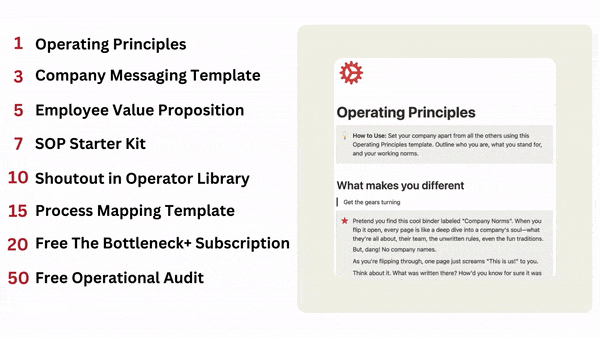
Read Time: 7.3 Minutes
Good Morning Operators ⚙️
Today is the launch day of The Bottleneck+! For those of you who upgraded your membership, expect an email from me to get onboarded.
If you haven’t had a chance to check out our membership program, go ahead and click here to learn more.
While you review that page, here is what we are talking about this week:
Strategy therapy: Encourage leaders to confront tough truths for effective strategic planning.
Referral programs with virality: Combine viral loops with referral programs to supercharge acquisition
The Next Next Job framework: Forecast your career trajectory to position yourself for future roles
Let’s dive in.

Together With Xembly
Xembly – Boost work productivity by 20%
Accelerate your company by delegating admin tasks like scheduling, note-taking, and task tracking to AI.
With Xembly’s AI executive assistant, Xena, you can bring people together in seconds, run meetings like a boss, and get 400 hours extra every year.
What will you accomplish with the power of AI?

1. Switch from Strategy Planning to Strategy Therapy
Insight from HBR
You know, when we talk about strategy planning, it's usually this very logical, outward-looking kind of thing that's all about crunching numbers and analyzing the market.
But here's a thought: maybe what really makes for a healthier and more effective strategy session isn't piling on more analysis.
Enter strategy therapy.
Strategy therapy uses the same tools as traditional strategy planning, but the twist is that it nudges leaders to tackle those tough conversations they'd rather avoid.
Let's break strategy down to its basics.
At its core, strategy is just about nailing three honest answers:
1. Where are we right now?
2. Where do we want to go?
3. How do we realistically get there?
A big stumbling block for a lot of companies is that first question. There's often a lack of real talk about their strengths and weaknesses.
Here's where strategy therapy swings in.
It's about getting embarrassingly honest about what you believe about your strategy and what truly makes your products or your company stand out.
When building out your company, here are 3 questions to ask yourself:
What is the one thing that makes your business special?
Identifying what makes our business special is crucial. Is it the product, benefits or pricing, or the company's marketing, sales, or supply chain strengths?
How special is the one thing that makes your business special?
Honest strategy exercises, like evaluating price elasticity, marketing effectiveness, and sales versus advertising spend, reveal the true market impact.
How far will we go to make the one thing truly special?
There are three ambitions a business can aim for: dominating the market and prioritizing cost efficiency over innovation; focus on excellence, innovation, and commanding a higher price; or seeking to be unique.
Most leaders aim for just being better, but the real game-changers dare to aim for the best or uniquely different.
That's exactly why strategy therapy trumps traditional strategy planning.
2. Don’t rely on your referral program
Insight from Andrew Chen
Referral programs can decrease CAC, increase brand awareness, and bring in new customers.
The most famous is Dropbox's referral program.
However, most referral programs fizzle out.
These programs become less effective because as more users have adopted the product, the fewer friends there are to invite.
To keep growth going, what you really need to build is a viral growth loop combined with a referral program.
A viral growth loop is a strategy used within a product or service that makes people want to share it with their friends.
For example, a feature in a social media app that allows users to share content with their network is a viral growth mechanism. As users engage with this feature, they unintentionally promote the app to new potential users.
The key is that these features are appealing to the existing user base, making the act of sharing feel less like a promotion and more like a natural part of using the product.
For example, in Dropbox, you can share files and work on projects with others. This feature makes people want to bring their friends to use Dropbox too.
Or in Uber, when you use the "Share ETA" feature to let your friends know when you'll arrive, you're also showing them how Uber works, which might make them want to try it.
So, a viral growth mechanism is all about making sharing a normal part of using the app, which helps it grow because more and more people start using it.
As you build out your referral program, try to keep virality in mind!
3. The Next Next Job Framework
Insight from Andrew Chen
Thinking about your career, right? Well, have you ever thought about not just your next job but the one after that? That's what the "Next Next Job" idea by Andrew Chen is all about.
I used this trick myself when figuring out what to do after my second startup. I had to pick between several job offers and let me tell you; it was like riding a super intense rollercoaster. Each job had its vibe and perks, so choosing was tough.
First things first, figuring out your next next job can be a bit like trying to grab fog – it's tricky! But here's the cool part: you can start making some educated guesses. Imagine a pie chart of possibilities.
For me, it looked like this: 50% chance I'd become a startup founder again, 30% chance I'd go create content, 10% chance I'd join a high-growth startup as an exec, and another 10% for, well, who knows? Maybe I'd jump into a brand-new industry.
Most jobs are within reach. But hey, sometimes there's a good reason why that dream job is still out of reach.
Maybe your resume needs a bit of sparkle with some shiny roles, or you're in marketing, dreaming of being a product manager, but you're not quite tech-savvy yet. Or maybe you've never managed a team, and you need that experience to step up. Spotting these gaps is key to figuring out what jobs will help you bridge them.
So, what gaps are we talking about? It could be anything – skills, network, experiences, mentors, you name it. Ask yourself some questions like:
What new skills do I need?
Who should I be rubbing elbows with?
What experiences do I need under my belt?
Who are the mentors that can guide me?
And what ideas will spark my next big move?
Let's take an example: Say you want to be an investor. You've got tons of experience in behind-the-scenes roles at successful startups.
Here's what your gap list might look like:
You need to build a personal brand
You haven't done any angel investing yet
You need to form opinions on the latest and greatest in tech
Remember, it's not just about playing defense and filling those gaps. It's also about finding that one thing that makes you stand out – your superpower. That's what will give you an edge in the game.
4. How a Board Makes Decisions
Insight from CFO Secrets
Majority votes are rare - everyone talks about it, but you hardly ever see one in action. But when the stakes are high, like in that nail-biter finale of "Succession", everyone's on the edge of their seats, avoiding glances as if eye contact is radioactive.
But let's be real, most boardrooms aren't brewing with HBO-level drama.
An effective board will set a delegation of authorities (DOA). This is a fancy way of saying what the business can or can't do without getting permission from the BoD. The CEO, CFO, COO, etc. must then make sure to observe these.
This will include M&A, capital investment above a certain level, major strategy changes, entering contracts above a certain length, etc.
The DOA is a critical document. If you are a CFO, there is an expectation from the BoD that you will be a police(wo)man.
If the BoD DOA says that any capex above $5m must be approved by the BoD, but your VP of Ops exceeds that authority by committing to a $7m investment, you will be expected to blow the whistle on it to the BoD.
And then they'll ask you how it happened and why your controls didn't prevent it. Good questions.
Fail to follow the DOA? That's a fast track to getting fired.

Operators Library
P.S. To get featured in this section, share the newsletter 10 times (your referral link is below), and I'll include you in a future issue. Here is your referral link.

How I Can Help
In case you're new: Who's The Bottleneck?
We’re on a mission to help you build, manage, and scale your startup.
We share high-quality, vetted, and actionable operational content as we learn it from the top 1% of operators.
How we can help you scale:
Upgrade to premium to get access to exclusive content, tools and more here
👀 Get your product in front of startup operators by sponsoring this newsletter.
🤝 Grab time with me for a 1:1 session


Support
Small ask: If you enjoyed today’s post, I’d be incredibly grateful if you helped others discover The Bottleneck. Please hit me with a fav or repost on my tweet below.

Spread The Word
Share The Bottleneck with friends to get a few freebies. Maybe you’ll make some new ones on the way 😆
We’ll give you free stuff and more friends if you share a link. Only one link.

{{rp_personalized_text}}



